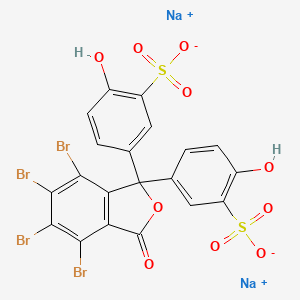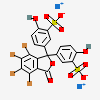Bromosulfalein
- Bromosulfalein
- 71-67-0
- Bromosulfophthalein
- bromsulphthalein
- Bromsulphalein
- Create:2005-06-24
- Modify:2025-01-18

- Bromosulfophthalein
- Bromosulphthalein
- Bromsulphalein
- Bromthalein
- Disodium, Sulfobromophthalein
- Sodium, Sulfobromophthalein
- Sulfobromophthalein
- Sulfobromophthalein Disodium
- Sulfobromophthalein Sodium
- Tetrabromsulphthalein
- Bromosulfalein
- 71-67-0
- Bromosulfophthalein
- bromsulphthalein
- Bromsulphalein
- Bromthalein
- Hepatestabrome
- Hepatosulfalein
- Hepartest
- Bromosulphthalein
- BSP sodium
- Bromsulfalein
- Sodium bromosulfalein
- Sodium bromsulphalein
- Sodium bromsulphthalein
- Sulfobromophthalein disodium salt
- Sodium bromosulfophthalein
- Sodium sulphobromophthalein
- Sulphobromophthalein sodium
- Disodium bromosulfophthalein
- Tetrabromophenolsulfophthalein
- Sodium phenol tetrabromophthalein
- SODIUM SULFOBROMOPHTHALEIN
- Disodium phenoltetrabromophthalein sulfonate
- DTXSID9023621
- CHEBI:63827
- 4,5,6,7-Tetrabromo-3',3''-disulfophenolphthalein disodium salt
- DTXCID503621
- Bromsulfthalein
- Hepartestabrome
- Bromotaleina
- Brom-tetragnost
- Bromsulfophthalein
- BSF simes
- CAS-71-67-0
- Benzenesulfonic acid, 3,3'-(4,5,6,7-tetrabromo-3-oxo-1(3H)-isobenzofuranylidene)bis(6-hydroxy-, disodium salt
- Benzenesulfonic acid, 3,3'-(4,5,6,7-tetrabromo-3-oxo-1(3H)-isobenzofuranylidene)bis[6-hydroxy-, disodium salt
- BSF
- disodium 3,3'-(4,5,6,7-tetrabromo-3-oxo-1,3-dihydro-2-benzofuran-1,1-diyl)bis(6-hydroxybenzenesulfonate)
- CBSP
- Bromsulphalein R sodium
- NCGC00159391-02
- NCGC00159391-03
- UNII-62E5JU30OV
- HSDB 2183
- disodium 2-hydroxy-5-[4,5,6,7-tetrabromo-1-(4-hydroxy-3-sulfonatophenyl)-3-oxo-1,3-dihydro-2-benzofuran-1-yl]benzene-1-sulfonate
- EINECS 200-761-0
- Sulfobromophthalein sodium [USP:JAN]
- bromsulphthalein sodium
- bromosulfophthalein sodium
- [3H]BSP
- SCHEMBL487073
- [3H]-BSP
- CHEMBL453904
- GTPL4505
- GTPL4506
- bromosulfophthalein disodium salt
- Sulfobromophthalein sodium (JP17)
- Tox21_111628
- AKOS024373601
- Tox21_111628_1
- 5,5'-(4,5,6,7-Tetrabromo-3-oxo-1(3H)-isobenzofuranylidene)bis(2-hydroxybenzenesulfonic acid) disodium salt
- DA-58185
- Disodium 6,6'-dihydroxy-3,3'-(4,5,6,7-tetrabromo-1,3-dihydro-3-oxoisobenzofuran-1-ylidene)dibenzenesulphonate
- NS00079056
- D02210
- G12059
- Q926998
- 4,5,6,7-Tetrabromo-3',3'-disulfophenolphthalein disodium salt

H317 (100%): May cause an allergic skin reaction [Warning Sensitization, Skin]
H334 (100%): May cause allergy or asthma symptoms or breathing difficulties if inhaled [Danger Sensitization, respiratory]
P233, P260, P261, P271, P272, P280, P284, P302+P352, P304+P340, P321, P333+P317, P342+P316, P362+P364, P403, and P501
(The corresponding statement to each P-code can be found at the GHS Classification page.)
Aggregated GHS information provided per 40 reports by companies from 1 notifications to the ECHA C&L Inventory. Each notification may be associated with multiple companies.
Information may vary between notifications depending on impurities, additives, and other factors. The percentage value in parenthesis indicates the notified classification ratio from companies that provide hazard codes. Only hazard codes with percentage values above 10% are shown.
Skin Sens. 1 (100%)
Resp. Sens. 1 (100%)
Patents are available for this chemical structure:
https://patentscope.wipo.int/search/en/result.jsf?inchikey=GHAFORRTMVIXHS-UHFFFAOYSA-L
- ChEBIBromosulfophthalein sodiumhttps://www.ebi.ac.uk/chebi/searchId.do?chebiId=CHEBI:63827
- ChEMBLLICENSEAccess to the web interface of ChEMBL is made under the EBI's Terms of Use (http://www.ebi.ac.uk/Information/termsofuse.html). The ChEMBL data is made available on a Creative Commons Attribution-Share Alike 3.0 Unported License (http://creativecommons.org/licenses/by-sa/3.0/).http://www.ebi.ac.uk/Information/termsofuse.htmlChEMBL Protein Target Treehttps://www.ebi.ac.uk/chembl/g/#browse/targets
- ChemIDplusSulfobromophthalein sodium [USP:JAN]https://pubchem.ncbi.nlm.nih.gov/substance/?source=chemidplus&sourceid=0000071670ChemIDplus Chemical Information Classificationhttps://pubchem.ncbi.nlm.nih.gov/source/ChemIDplus
- EPA Chemicals under the TSCABenzenesulfonic acid, 3,3'-(4,5,6,7-tetrabromo-3-oxo-1(3H)-isobenzofuranylidene)bis[6-hydroxy-, disodium salthttps://www.epa.gov/chemicals-under-tscaEPA TSCA Classificationhttps://www.epa.gov/tsca-inventory
- EPA DSSToxSulfobromophthaleinhttps://comptox.epa.gov/dashboard/DTXSID9023621CompTox Chemicals Dashboard Chemical Listshttps://comptox.epa.gov/dashboard/chemical-lists/
- European Chemicals Agency (ECHA)LICENSEUse of the information, documents and data from the ECHA website is subject to the terms and conditions of this Legal Notice, and subject to other binding limitations provided for under applicable law, the information, documents and data made available on the ECHA website may be reproduced, distributed and/or used, totally or in part, for non-commercial purposes provided that ECHA is acknowledged as the source: "Source: European Chemicals Agency, http://echa.europa.eu/". Such acknowledgement must be included in each copy of the material. ECHA permits and encourages organisations and individuals to create links to the ECHA website under the following cumulative conditions: Links can only be made to webpages that provide a link to the Legal Notice page.https://echa.europa.eu/web/guest/legal-noticeDisodium 6,6'-dihydroxy-3,3'-(4,5,6,7-tetrabromo-1,3-dihydro-3-oxoisobenzofuran-1-ylidene)dibenzenesulphonatehttps://echa.europa.eu/substance-information/-/substanceinfo/100.000.692Disodium 6,6'-dihydroxy-3,3'-(4,5,6,7-tetrabromo-1,3-dihydro-3-oxoisobenzofuran-1-ylidene)dibenzenesulphonatehttps://echa.europa.eu/substance-information/-/substanceinfo/100.154.783Disodium 6,6'-dihydroxy-3,3'-(4,5,6,7-tetrabromo-1,3-dihydro-3-oxoisobenzofuran-1-ylidene)dibenzenesulphonate (EC: 200-761-0)https://echa.europa.eu/information-on-chemicals/cl-inventory-database/-/discli/details/130160Disodium 6,6'-dihydroxy-3,3'-(4,5,6,7-tetrabromo-1,3-dihydro-3-oxoisobenzofuran-1-ylidene)dibenzenesulphonate (EC: 626-376-1)https://echa.europa.eu/information-on-chemicals/cl-inventory-database/-/discli/details/159385
- Hazardous Substances Data Bank (HSDB)SODIUM SULFOBROMOPHTHALEINhttps://pubchem.ncbi.nlm.nih.gov/source/hsdb/2183
- Haz-Map, Information on Hazardous Chemicals and Occupational DiseasesLICENSECopyright (c) 2022 Haz-Map(R). All rights reserved. Unless otherwise indicated, all materials from Haz-Map are copyrighted by Haz-Map(R). No part of these materials, either text or image may be used for any purpose other than for personal use. Therefore, reproduction, modification, storage in a retrieval system or retransmission, in any form or by any means, electronic, mechanical or otherwise, for reasons other than personal use, is strictly prohibited without prior written permission.https://haz-map.com/AboutSulfobromophthalein sodiumhttps://haz-map.com/Agents/17790
- IUPHAR/BPS Guide to PHARMACOLOGYLICENSEThe Guide to PHARMACOLOGY database is licensed under the Open Data Commons Open Database License (ODbL) https://opendatacommons.org/licenses/odbl/. Its contents are licensed under a Creative Commons Attribution-ShareAlike 4.0 International License (http://creativecommons.org/licenses/by-sa/4.0/)https://www.guidetopharmacology.org/about.jsp#licenseGuide to Pharmacology Target Classificationhttps://www.guidetopharmacology.org/targets.jsp
- Therapeutic Target Database (TTD)bromsulphthaleinhttps://idrblab.net/ttd/data/drug/details/D0W8GY
- KEGGLICENSEAcademic users may freely use the KEGG website. Non-academic use of KEGG generally requires a commercial licensehttps://www.kegg.jp/kegg/legal.htmlAnatomical Therapeutic Chemical (ATC) classificationhttp://www.genome.jp/kegg-bin/get_htext?br08303.kegDrugs listed in the Japanese Pharmacopoeiahttp://www.genome.jp/kegg-bin/get_htext?br08311.keg
- NCI Thesaurus (NCIt)LICENSEUnless otherwise indicated, all text within NCI products is free of copyright and may be reused without our permission. Credit the National Cancer Institute as the source.https://www.cancer.gov/policies/copyright-reuseNCI Thesaurushttps://ncit.nci.nih.gov
- PharosLICENSEData accessed from Pharos and TCRD is publicly available from the primary sources listed above. Please respect their individual licenses regarding proper use and redistribution.https://pharos.nih.gov/aboutbromsulphthaleinhttps://pharos.nih.gov/ligands/PBV386QP2LHX
- SpectraBase3',3''-DISULFO-4,5,6,7-TETRABROMOPHENOLPHTHALEIN, DISODIUM SALThttps://spectrabase.com/spectrum/JoeZhvz24FTsulfobromophthalein, disodium salthttps://spectrabase.com/spectrum/Cs2neX1eeapSULFOBROMOPHTHALEIN SODIUMhttps://spectrabase.com/spectrum/E8yvZyYRMDFSULFOBROMOPHTHALEIN, DISODIUM SALThttps://spectrabase.com/spectrum/BZxMQx0znMV
- Springer Nature
- Wikidatabromsulphthalein sodiumhttps://www.wikidata.org/wiki/Q926998
- WikipediaBromsulfthaleinhttps://en.wikipedia.org/wiki/Bromsulfthalein
- Medical Subject Headings (MeSH)LICENSEWorks produced by the U.S. government are not subject to copyright protection in the United States. Any such works found on National Library of Medicine (NLM) Web sites may be freely used or reproduced without permission in the U.S.https://www.nlm.nih.gov/copyright.htmlSulfobromophthaleinhttps://www.ncbi.nlm.nih.gov/mesh/68013448Indicators and Reagentshttps://www.ncbi.nlm.nih.gov/mesh/68007202Coloring Agentshttps://www.ncbi.nlm.nih.gov/mesh/68004396
- PubChem
- GHS Classification (UNECE)GHS Classification Treehttp://www.unece.org/trans/danger/publi/ghs/ghs_welcome_e.html
- NORMAN Suspect List ExchangeLICENSEData: CC-BY 4.0; Code (hosted by ECI, LCSB): Artistic-2.0https://creativecommons.org/licenses/by/4.0/NORMAN Suspect List Exchange Classificationhttps://www.norman-network.com/nds/SLE/
- EPA Substance Registry ServicesEPA SRS List Classificationhttps://sor.epa.gov/sor_internet/registry/substreg/LandingPage.do
- PATENTSCOPE (WIPO)SID 403438509https://pubchem.ncbi.nlm.nih.gov/substance/403438509


 CID 5345 (Sulfobromophthalein)
CID 5345 (Sulfobromophthalein) CID 5360545 (Sodium)
CID 5360545 (Sodium)